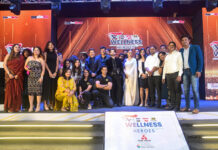Swati Singh’s tale of transformation follows Madhumita, a girl betrayed in love, as she evolves into a self-made, fearless woman. From her humble mountain village to bustling Mumbai, Madhumita navigates love, betrayal, and self-discovery. With her friend Natasha by her side, she forges her own path, finding love and success while overcoming adversity. This captivating narrative resonates with ambitious women seeking empowerment and contentment in their lives. Through Madhumita’s journey, readers find inspiration and insights into the complexities of love, ambition, and self-realization. Join Madhumita on her quest for happiness and fulfillment in a story that celebrates resilience, friendship, and the power of choice.
1. What motivated you to write this specific novel, and how did the plot develop?
To answer your question, this book was inspired by my buddy Dr. Anshima. She has loved reading since our MBBS years. She inspired me to read outside of our coursework. The real motivation is her.
The story’s idea is entirely made up. Each and every character is made up. The story itself began to take shape in my head and spill onto the paper when I began writing.
2. Could you elaborate on your writing process? Do you have any special rituals or a set schedule that you follow to help you enter the creative flow?
This book was written in 2019. It was merely pen and paper. To be honest, I never imagined that it would become a book. I had fun writing. I wrote down my feelings and used words to convey them. Writing out my feelings made me feel incredibly satisfied.
For this, there was no set routine. I used to write in the afternoons since I had a lot of work in the mornings seeing patients. I used to picture the image in my head when I would go for walks. I used to repeatedly create the same scene and then, when I had more time, I would write those down. I used to think that creativity is at its peak when I was strolling and taking in the stunning scenery.
3. Your book features a cast of distinctly unique and endearing characters. Did they come from your imagination alone, or are they based on real people?
The characters are entirely made up, is the response. They are not inspired by anyone, nor do they share any similarities with anyone. Characters that are entirely made up, and the plot is entirely made up. However, I must admit that I had these characters all over my head as I was writing the novel. I spent around three months composing this narrative in its entirety, and during that time, every character in it existed solely in my head and imagination. I used to take them on evening walks.
4. Your book explores [a particular topic or problem]. What inspired you to investigate this issue, and what ideas or conversations do you want readers to have after reading your writing?
The topic is romance and love since it’s a fictional love story. There’s a twist, though. In reality, infancy teaches us that love is blind, that it’s all about attraction, and other such things. However, I realized that it’s really simple to start a relationship at my age. How you handle things in that relationship is what counts. And for a better result, the respect you receive in that connection is more crucial than desire. The same ideas have guided my work throughout this book.
Since it’s a made-up love story, romance and love are the main topics. But there’s a catch. In actuality, childhood imparts knowledge such as the notion that attraction is the only factor in love and that love is blind. But I also came to the realization that, given my age, dating is actually quite easy. What matters in that relationship is how you manage things. And more important than desire for a better outcome is the respect you get in that relationship. For this book, I have worked from the same principles.
5. The world-building in your book is very detailed and captivating. What steps did you take to create the environment, and were there any historical events or real-world locales that you found inspiring?
The narrative and all of the characters are imaginary, as I already stated. Writing a story based on a whole made-up notion is incredibly challenging. I’m currently working on my second book, which is a fictional love story with a male lead this time. Returning to Rise In Love, I would want to inform everyone that the locations I pictured in my mind’s eye when crafting scenes for this book—a cafeteria, college campus, and hostel—were all from my college, Government Medical College, (Aurangabad), Chhatrapati Sambhaji Nagar.
I would picture my college campus, dorm, and canteen in the background while I imagined the scene before writing it down. Even if the girls in this narrative aren’t medical students, I think college campuses, canteens, and dorm life are all the same.
6. As a writer, how do you strike a compromise between the genre’s expectations and the requirement for originality? Did you face any difficulties interpreting well-known components in your own way?
Love never goes out of vogue. All love stories are different from one another though. Every female is the protagonist of her own love story, regardless of what she does or where she is from. Every one of us is the main character in our own story. Because of this, I think every love story is unique and unusual. I’ve tried to narrate the story in an engaging manner. Everyone enjoys a good story with surprises. This book contains a lot of twists. A vast spectrum of feelings will be experienced, such as dread, fury, sad moments, romance, anguish, wrath, and anxiety. I hope you will enjoy reading this.
7. The story’s well-crafted pacing keeps readers interested from beginning to end. Could you describe how you keep the story moving forward and keeping tension high?
The book is emotional in every way. What a girl considers and how her views evolve over time. How she tries to convince her parents and society of her value. The story of how two girls became friends and relied on one another for assistance. How a girl must battle herself in order to identify her true love. My novel also has a secret message. In terms of both parenting and love. I sincerely hope you will learn about this soon, and if you do, kindly mail me with your thoughts.
8. How do you see the function of conventional storytelling changing in the age of quickly evolving media and reader preferences? How do you modify your writing to appeal to modern audiences?
The reason traditional storytelling is termed traditional is because it cannot be replaced by anything else. Books are regarded as both a person’s finest teacher and friend. This is still true today and it always will be. I use a variety of social networking sites, including Instagram, Threads, X, Jetpack, Pratilipi, networking, and Tumblr, to stay in touch with my fans. Although I write on these platforms quite a bit, books still hold a special position in people’s lives.




















